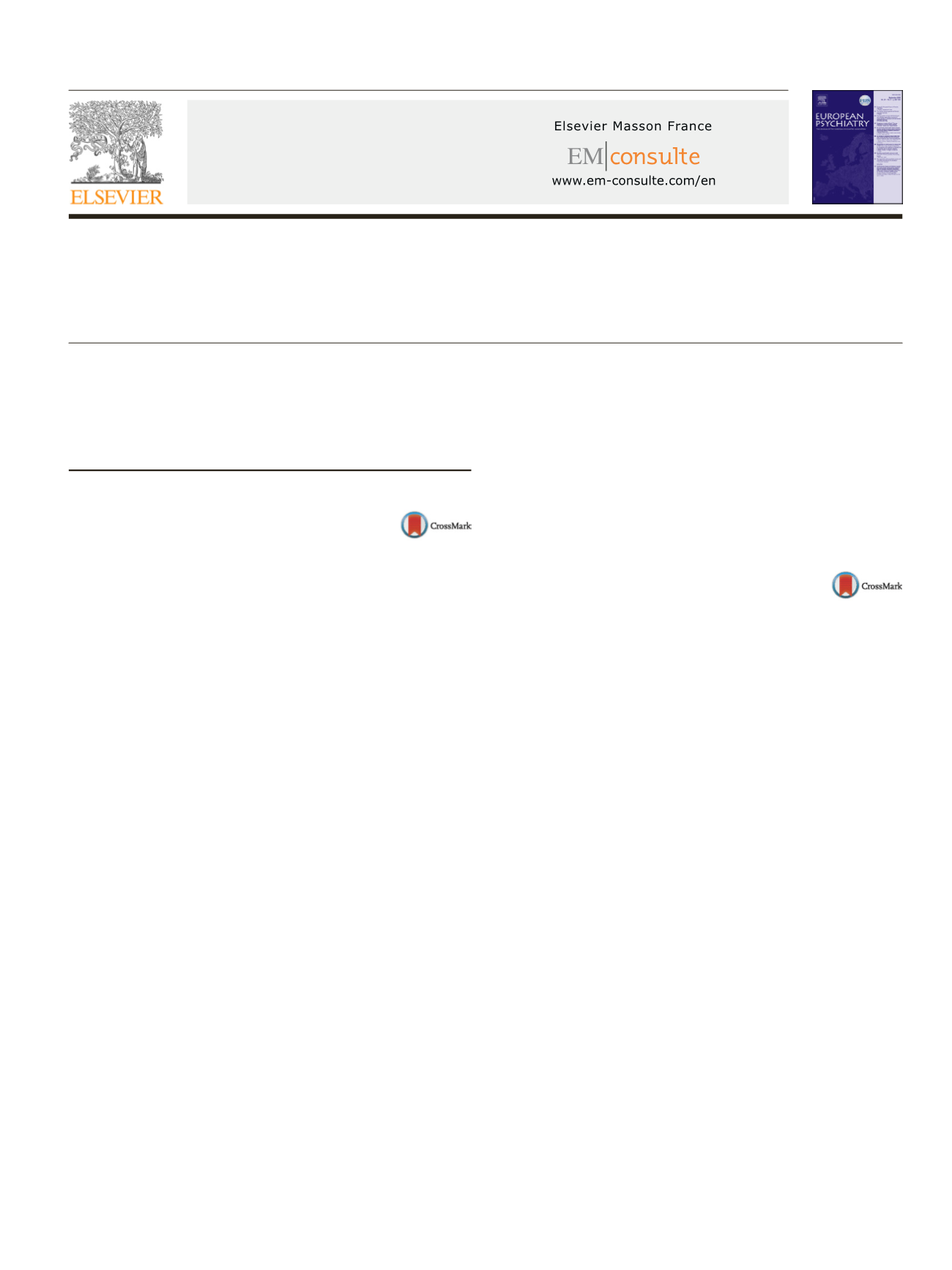
 European Psychiatry 41S (2017) S365–S404
European Psychiatry 41S (2017) S365–S404
Available online at
ScienceDirect
www.sciencedirect.com25th European congress of psychiatry
e-Poster walk part 5
e-Poster Walk: Psychopharmacology and
pharmacoeconomics and
psychoneuroimmunology
EW0752
Selective serotonine reuptake
inhibitors or dual antidepressants and
syndrome of inapropriate antidiuretic
hormone secretion: A systematic
search
I. Alberdi-Paramo
1 ,∗
, G .Montero
1 , L. Niell
1 , R. Baena
1 ,M. Tenorio
1 , A.Carabias
1 , D.Fuentes
1 , A. Jurado
1 , C. Perez
1 ,R. Carrillo
2 , A. Fraga
3 , M.Fernandez De Aspe
4 , M.Soto
5 ,B. Gonzalez
61
Hospital Clinico San Carlos, Psiquiatria, Madrid, Spain
2
Complejo Hospitalario Insular Materno Infantil, Psiquiatria, Las
Palmas de Gran Canarias, Spain
3
Hospital Universitario La Paz, Psiquiatria, Madrid, Spain
4
Complexo Hospitalario de Ourense, Psiquiatria, Ourense, Spain
5
Hospital provincial de la misericordia, Psiquiatria, Toledo, Spain
6
Hospital Universitario de Alava, Psiquiatria, Vitoria-Gazteiz, Spain
∗
Corresponding author.
Introduction
Depression is a diseasewith high prevalence all over
theworld. Selective serotonine reuptake inhibitors (SSRIs) and dual
antidepressants (DA) are worldwide used to treat the different
types of depressive episodes. Between the adverse events of these
compounds, an unusual but potentially severe side effect is the
syndrome of inapropriate antidiuretic hormone secretion (SIADH).
Results and discussion
Several cases published, and an amount of
cases series have documented the association of SIADH to the use
of SSRIs and DA. All SSRIs and DA are at risk of producing SIADH
(fluoxetine, paroxetine, fluvoxamine, sertraline, citalopram, esci-
talopram, venlafaxine and duloxetine). Old age has been found as a
risk factor for developing SIADH. There are not enough data to con-
clude that other risk factors can play a role in the development
of this adverse event. Treatment should include the immediate
withdrawal of the antidepressant. The introduction of other antide-
pressants is controversial, as SIADH has been related with all
antidepressive treatments; but the risk of relapse into a depressive
episode must be considered also. Between symptomatic treat-
ments, the control of water intake and the use of low doses of loop
diuretics can be recommended. Severe cases can be treated with
higher doses of loop diuretics and saline hypertonic solution.
Conclusions
SIADH has been related with SSRIs and DA antide-
pressants and it is an infrequent but severe adverse event. Its risk
must be considered when prescribing treatment with them. If this
adverse event is produced, the substitution of the antidepressant
should be done.
Disclosure of interest
The authors have not supplied their decla-
ration of competing interest.
http://dx.doi.org/10.1016/j.eurpsy.2017.02.366EW0753
Anti-inflammatory properties of
brilliant blue G on chronic
unpredictable mild stress-induced
changes in rat hippocampus
F. Aricioglu
1 ,∗
, T. Bastaskin
1, C. Kandemir
2, S. Sirvanci
2,
C. Ozkartal
1, T. Utkan
31
Marmara University School of Pharmacy, Department of
Pharmacology and Psychopharmacology Research Unit, Istanbul,
Turkey
2
Marmara University School of Medicine, Department of Histology
Embriology, Istanbul, Turkey
3
Kocaeli University School of Medicine, Department of
Pharmacology, Kocaeli, Turkey
∗
Corresponding author.
Objective
Purinergic 2X7 receptor (P2X7R) activation has
recently been considered to be involved in depression at least par-
tially by triggering microglial activation. The aim of the present
study was to examine whether the chronic administration of
brilliant blue G (BBG), a highly selective P2X7R antagonist, has
antidepressant-like effects and microglial (Iba-1) immunoreactiv-
ity in chronic unpredictable mild stress (CUMS) model in rats.
Methods
Male Wistar Albino rats (290–360 g) were divided
into groups such as control (saline), CUMS, CUMS + Imipramine
(20mg/kg; i.p.), CUMS + BBG25 (25mg/kg; i.p.), CUMS + BBG50
(50mg/kg; i.p.) groups (
n
= 10–12 in each). In CUMS model, vari-
ous stressors were applied for 40 days. On day 20, the treatment
of BBG was started for 20 days. At the end, sucrose preference and
forced swimming tests were performed. Then brains were removed
with paraformaldehyde perfusion for Iba-1 immunohistochemical
analysis in hippocampus. One-way analysis of variance and Tukey’s
test were used for statistical analysis.
Results
The time of immobility in forced swim test was sig-
nificantly reduced while sucrose preference was increased in
Imipramine and CUMS + BBG50 groups compared to control and
0924-9338/


















